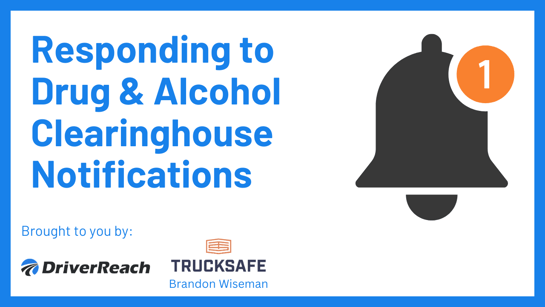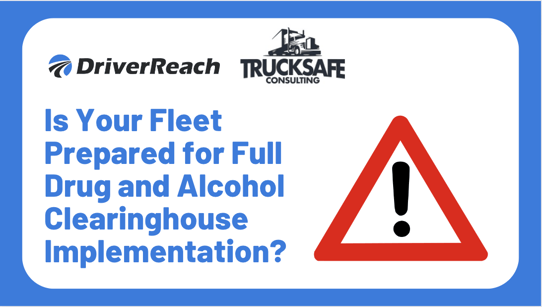Did you have a chance to attend our recent webinar, “FMCSA’s New & Inevitable Crash Preventability Determination Program”? We received more questions than we had time to answer in the allotted time frame, so our presenters from Scopelitis Transportation Consulting have answered them below in this Q&A-style blog post. If you weren’t able to join the live webinar, don’t worry – you can watch it on-demand anytime!
Question: If an accident is eligible for 2 crash eligible types under the determination program, which one should we choose in order for DataQ to accept it? We have to file the Accident under both categories?
Answer: No, you should select the crash type you believe it best fits within. To help make this decision, you should review FMCSA’s crash eligibility guide found at https://www.fmcsa.dot.gov/sites/fmcsa.dot.gov/files/2020-02/CPDP%20Eligibility%20Guide.pdf. If the reviewer believes the crash fits another type more closely, they have the ability to change the crash type for you.
Question: I was just recently denied a crash review. The reason was the crash was not caused by stopped traffic. I had a police report and dash camera footage showing that a drunk driver merged into my truck, was not preventable. What did I do wrong there?
Answer: The crash you describe appears to fit within the “Under the Influence” crash type, but the Police Accident Report you submit to FMCSA must include information the driver was cited or arrested with driving under the influence, or failed a field sobriety test. See page 8 of FMCSA’s crash eligibility guide. https://www.fmcsa.dot.gov/sites/fmcsa.dot.gov/files/2020-02/CPDP%20Eligibility%20Guide.pdf
Question: What information is mandatory for an ACCIDENT TO BE FILED to Data Q under Determination Program?
Answer: Here’s a link to a helpful document from FMCSA that walks users through the process for submitting and monitoring a request. https://www.fmcsa.dot.gov/sites/fmcsa.dot.gov/files/2020-04/DataQs%20CPDP%20Submitters%20Job%20Aid.pdf
Question: Can you provide us an example of Rare and Unusual type of crash? This crash type is listed in DATAQ.
Answer: FMCSA has provided 3 examples: being struck by an airplane; being struck by a skydiver; or being struck by a deceased driver. These are just examples, and the category is not limited to these three crash types.
Question: For what period of time this program will be open?
Answer: This new program began on May 6, 2020, and it is a permanent program. Crashes occurring on and after August 1, 2019, and that meet one of the eligible crash types, are reviewable under the program.
Question: I recently went through an audit due to a 91% critical on crash. The auditor was not able to submit the non-preventable to the FMCSA. 10 of our accidents were determined by the auditor to be non-preventable. What do I need to do to submit these?
Answer: Preventability determinations made during an audit are done for safety rating purposes, and are completely separate from FMCSA’s crash preventability determination program. If the 10 crashes evaluated by the auditor meet the new crash preventability program eligibility criteria at this link you will need to submit them to FMCSA via DataQs. If they are found to be not preventable under the new program, they will be excluded when your Crash Indicator BASIC score is calculated.
Question: What about suicide by truck? Would that also be in the catch all?
Answer: Suicide is an eligible crash type. See page 12 of FMCSA’s crash eligibility guide at https://www.fmcsa.dot.gov/sites/fmcsa.dot.gov/files/2020-02/CPDP%20Eligibility%20Guide.pdf
Question: Which crash type would "Multiple Vehicle Crashes" fall under?
Answer: For the purposes of the webinar, we intended to highlight new crash scenarios that were added and, in this case, combined a few into a new category we called “Multiple Vehicle Crashes.” They are broken down as follows:
- Wrong Direction Multiple-Vehicle Crashes: These are crashes in which a vehicle is traveling in the wrong direction and strikes a second vehicle, which ultimately strikes the CMV. To be eligible, the vehicle traveling in the wrong direction must be fully over the centerline or median.
- Legally Stopped Multiple-Vehicle Crashes: These are crashes in which the CMV was legally stopped by a traffic control device and a vehicle strikes a second vehicle which ultimately contacts the CMV.
- Under the influence Multiple-Vehicle Crashes: These are crashes where an intoxicated driver strikes a vehicle which ultimately strikes the CMV. To be eligible for this category, the driver must have failed a field sobriety test which was documented on the police accident report.
Question: Preventable? Fatigued driver at night in heavy rain find the rest area full. He decides to stop driving for safety and parks at the end of a row of parked trucks at the rest area exit on the shoulder of I-85. Activates flashers and goes into Sleeper. He is struck by a car which was traveling too fast for the conditions, lost control of the vehicle and spun out into the trailer and tractor (2 impacts). Both vehicles towed, no serious injuries. Sleeping driver cited for improper parking. Is there a chance this crash could be removed?
Answer: This one is a little tricky. The eligibility guide now lists a “CMV was parked in the breakdown lane when the vehicle struck the CMV” as a crash type that can be contested, but the citation has the potential to trip you up because the crash type is “parked or legally stopped.” The citation implies that the driver wasn’t legally stopped and perhaps shouldn’t have been there. It is reasonable to submit this but there’s a risk that the final determination is “preventable.”
Question: In the past when there were no changes made I would receive an email stating no change made. Now, if there are changes being made, will I still get an email explaining that?
Answer: Yes, when a DataQs requests for review (RDR) is resolved, the person that submitted the RDR receives an email briefly explaining the decision/resolution.
Question: Any idea why the new program only allows challenges to go back to 8/19?
Answer: The date was selected to preserve continuity of the program. Crashes that occurred after July 31, 2019 were not eligible for the pilot program. Beginning the permanent program on August 1 ensures there is no gap in crash eligibility.
Question: Where are the accidents challenged? Data Q?
Answer: Yes, crashes are challenged in this program using FMCSA’s DataQs system. Here is a link: https://dataqs.fmcsa.dot.gov/Default.aspx?enc=4orUr4VSakAlYsjxOmHrCeQ158IknHedB20QvqZJtcw=
Question: When does this new program begin?
Answer: The program began on May 6, 2020.
Question: Will more categories be added as more easily determined preventable crashes are identified?
Answer: We believe more crash categories will be added for the reason you mention – more easily determined preventable crashes are likely to be identified going forward.
Question: How will distracted driving in a crash be determined. Only by police report?
Answer: To be eligible, the driver must have admitted to being distracted and this must be documented on the police accident report.
Question: With the streamlining, what will the possible turnaround be for responses after an RDR has been submitted?
Answer: It is too early to know. It seems clear, though, that the turnaround time will likely be substantially shorter than the time taken during the pilot program. Keep in mind, though, that the State must have submitted the crash to FMCSA before the crash will be reviewed under this new program.=
Question: Multi vehicle crashes. What about 50 car pile-up in a snowstorm with 10 trucks involved? Will this be left off providing trucks are not at fault?
Answer: There is no crash type that would fit all instances of a multiple car pile up. There are, however, a few crash types that may fit specific circumstances. “Stopped in traffic” or “struck in rear” may be a good fit, among others. We advise you check FMCSA eligibility guide to determine if a crash type applies. https://www.fmcsa.dot.gov/sites/fmcsa.dot.gov/files/2020-02/CPDP%20Eligibility%20Guide.pdf
Question: When the crash is placed for the public for 30 days, do we know what "weight" will be placed on the public's opinion? Will there be any consideration of the transportation knowledge of trailers, etc.?
Answer: The mandatory 30-day public review period was only part of the pilot program, and is not a part of the new, permanent program. FMCSA will still take public input on any crash through email at crash.preventability@dot.gov and they have indicated they will fully consider any additional information. This say, during the two year pilot program, FMCSA only received two pieces of public input, neither of which were germain to the crash, so public input is not likely.
Question: Will we be able to challenge DOT Recordables that happened within the last 24 months? Or is this only for recordables that happen moving forward?
Answer: Only DOT recordable crashes that happen on or after August 1, 2019 will be reviewed under this new program.
Stay up to date on CDL trucking trends! Be sure to check out the DriverReach blog or follow us on LinkedIn for other relevant articles and head over to our webinars page for an up-to-date list of upcoming events and on-demand recordings.
Interested in seeing DriverReach’s modern Recruiting and Compliance Management System in action? Take DriverReach for a test drive!




